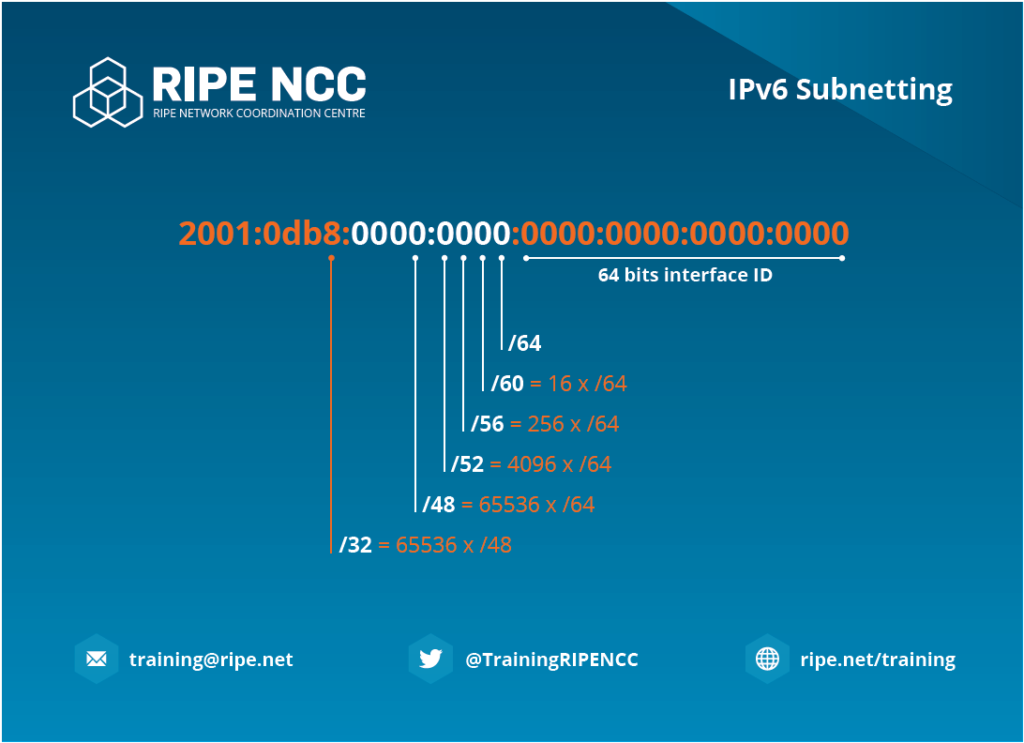Table of Contents
IPv6 has been defined in the RFC 2460 in 1998 and replaced with the RFC 8200 in 2017. It is the successor to IPv4 which shows many problems as time went on using it in larger amounts.
Notation
Since IPv6 consist of 128 bit a decimal notation similar to IPv4 wouldn’t be very efficient. Thats why the decision has fallen onto a hexadecimal notation.
2001:0db8:85a3:08d3:1319:8a2e:0370:7344Leading zeros inside a IPv6 block can be left out. Example:
2001:0db8:0000:08d3:0000:8a2e:0070:7344turns into
2001:db8:0:8d3:0:8a2e:70:7344If 2 or more blocks only containing zeros appear right after each other they can be replaced with two :
Example:
2001:db8:0000:0000:0000:0000:1428:57abturns into
2001:db8::1428:57abNotice the two : between db8 and 1428.
But this reduction is only allowed to happen once in the whole IPv6 address! Example:
2001:0db8:0:0:8d3:0:0:0can only turn into
2001:db8:0:0:8d3::or
2001:db8::8d3:0:0:0werden.
Thats why the following address is not a valid address:
2001:db8::8d3::URL Nntation: http://[2001:0db8:85a3:08d3::0370:7344]:8080/
The typical subnet sizes are present between /32 and /64.

Basically you can create more subnets after /64 but you will lose a pretty important feature – the “Stateless Address Autoconfiguration” (SLAAC). See bellow for further information.
Link Local and Global address
After connecting an interface to a network it is now default In IPv6 to automatically create a “link local” and (if a IPv6 prefix is present) a “global” address.
The “Link Local” address is used – as you probably already expected – only for the locally connected network. This address is always a part of the subnet fe80::/64
The “Global” address is used – as you probably already expected too – for the “global” network aka the “Internet”. But this address only appears if the connected router has a correctly configured IPv6 prefix.
Additionally there are “temporary” and “secured” IPv6 addresses for security reasons. What these are and why they are needed can be looked up right HERE.
New features of IPv6
Larger amount of available addresses
An IPv6 address has 128 bits – IPv4 only has 32 bits.
In comparison IPv6 has 340.282.366.920.938.463.463.374.607.431.768.211.456 (2128) and IPv4 only 4.294.967.296 (232) total available addresses.
Stateless Address Autoconfiguration (SLAAC)
To automatically get an IPv4 address assigned to your device there needs be a “DHCP” server present in the current network. Most of the time this is built into everyones wireless router.
But in a IPv6 network with at least a subnet size of /64 the MAC address of each client can be used as part of the IPv6 address. This is used for the “link-local” as well as the “global” address.
The following illustration just shows how a 48 bit MAC address and the 64 bit “link-local” prefix is used to automatically create an IPv6 address.

Implementation of security measures (IPsec)
The “Internet Protocol Security” (IPsec) is a protocol residing in the 3rd layer of the OSI-Layer Models which allows the encryption and authentication of IP packets.
Basically everyone know what HTTPS, SSL and TLS are but these protocols work on higher OSI layers (HTTPS in the 7th and TLS in der 4th). Thats why “someone” can still manipulate data in the 3rd layer.
Thats why the IPsec protocol has been integrated into the IPv6 standard.
Conservation of the “Point-to-Point principal“
The “Point-to-Point principal” says, that only the endpoints in a connection are allowed to perform active protocol operations, not the stations between the 2 clients. A global unique IP address per client is a requirement for that.
In the current state of the IPv4 network this is not possible since not every client in the world has a unique IPv4 address.
Reserved IPv6 spaces
As well as in IPv4 there are reserved spaces, which are used for specific “functionalities“.
| Adressblock (Prefix) | Usage | Referenz |
|---|---|---|
| ::1/128 | Loopback (Local Computer) | RFC 4291 |
| 2000::/3 | Global Unicast | RFC 4291 |
| FC00::/7 | Unique Local Unicast | RFC 4193 |
| FE80::/10 | Link Local Unicast | RFC 4291 |
| FF00:/8 | Multicast | RFC 4291 |
There are also special areas which are used just for “converting” IPv4 into IPv6 addresses such as z.B. 2002::/16 for the 6-to-4-Tunneling (see RFC 3056).
What Unicast and Multicast are can be looked up HERE.
Sources:
https://en.wikipedia.org/wiki/IPv6
